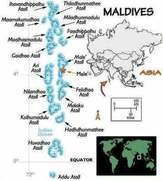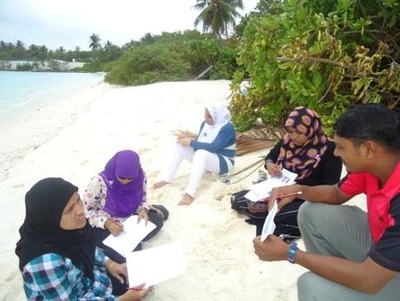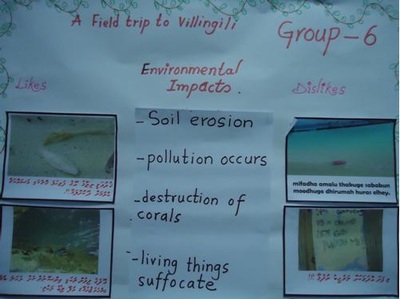The Maldives: Sandwatch activities started May 2006
Sandwatch in The Maldives
Beach erosion and the dumping of garbage on beaches are among the many environmental problems being faced in the Maldives. It was against this background that Sandwatch started in the Maldives, with the goal to provide a cross-curricular, hands-on, practical approach to environmental education that will equip students and teachers, as well as their communities, with the necessary tools to cope with such environmental problems.
In 2006 a Sandwatch workshop was held at the Baa Atoll Educational Centre on the island of Eydhafushi. Twenty-eight teachers from primary and secondary schools in 13 different islands took part in the workshop, which was supported by the Atoll Ecosystem-based Conservation Project (Baa Atoll) and Live and Learn Environmental Education.
However, Sandwatch is also an approach that can be adopted by communities, and in 2006 a series of activities, supported by Live and Learn Environmental Education were undertaken. These included the development of a Sandwatch Community toolkit, which provides a step-by-step approach for communities to learn about how their beaches are changing and to begin taking action to cope with beach erosion. A short presentation about this toolkit a(PowerPoint- 700kb)lso shows how it can be adapted for other island communities.
Beach erosion and the dumping of garbage on beaches are among the many environmental problems being faced in the Maldives. It was against this background that Sandwatch started in the Maldives, with the goal to provide a cross-curricular, hands-on, practical approach to environmental education that will equip students and teachers, as well as their communities, with the necessary tools to cope with such environmental problems.
In 2006 a Sandwatch workshop was held at the Baa Atoll Educational Centre on the island of Eydhafushi. Twenty-eight teachers from primary and secondary schools in 13 different islands took part in the workshop, which was supported by the Atoll Ecosystem-based Conservation Project (Baa Atoll) and Live and Learn Environmental Education.
However, Sandwatch is also an approach that can be adopted by communities, and in 2006 a series of activities, supported by Live and Learn Environmental Education were undertaken. These included the development of a Sandwatch Community toolkit, which provides a step-by-step approach for communities to learn about how their beaches are changing and to begin taking action to cope with beach erosion. A short presentation about this toolkit a(PowerPoint- 700kb)lso shows how it can be adapted for other island communities.
Sandwatch Updates from The Maldives (and Fiji)
Since attending the Sandwatch Regional Workshop in Seychelles in 2010, representatives from the Maldives and Fiji have been planning how to begin Sandwatch in their countries.
In The Maldives, Aminath Mohamed from the Ministry of Education, has been working to include aspects of Sandwatch in the Science curriculum from Kindergarten to Grade 12. A training workshop for primary school teachers is planned later this year.
In Fiji, Dr. Brij Lal from the Ministry of Education has been working to include some of the environmental stewardship aspects of Sandwatch into scouting and guiding activities. In particular, environmental care is being included in every scout and guide camp. This includes environmental clean-ups and tree planting activities. The 11th Fiji National Scouts Jamboree in Nadi from 22nd to 26th August focused on the theme “Nature Nurtures Scouting”. The weeklong event was attended by 1000 Scouts and all the activities were related to nature and the environment. Community work included beach clean-ups and tree planting. While opening the Jamboree the President of the Republic of Fiji, Ratu Epeli Nailatikau, said: “Scouts had access to the natural resources required for their training and survival skills and had a duty to protect the environment.”
A review of the school curriculum is underway in Fiji and environmental content is being integrated into the school curriculum starting with Years 1-4. Some of the concepts in the Sandwatch approach, e.g. observing and recording, analysing the results, and communicating with elders in the community to share their findings are included in the revised curriculum.
Also in Fiji, Morena Rigamoto from Live and Learn Environmental Education has been working to introduce a project on “Peace Building” in primary schools in Fiji. This project is being supported by the Ministry of Education. The project will introduce peace building principles to 200 schools. For those schools located on the coastline, this will be an opportunity to introduce Sandwatch. This project may also be expanded by Live and Learn to their programmes in Solomon Islands, Papua New Guinea and Vanuatu.
By Aminath Mohamed, Ministry of Education, Maldives, Brij Lal, Ministry of Education, Fiji.
Morena Rigamoto, Live and Learn Environmental Education, Fiji
Since attending the Sandwatch Regional Workshop in Seychelles in 2010, representatives from the Maldives and Fiji have been planning how to begin Sandwatch in their countries.
In The Maldives, Aminath Mohamed from the Ministry of Education, has been working to include aspects of Sandwatch in the Science curriculum from Kindergarten to Grade 12. A training workshop for primary school teachers is planned later this year.
In Fiji, Dr. Brij Lal from the Ministry of Education has been working to include some of the environmental stewardship aspects of Sandwatch into scouting and guiding activities. In particular, environmental care is being included in every scout and guide camp. This includes environmental clean-ups and tree planting activities. The 11th Fiji National Scouts Jamboree in Nadi from 22nd to 26th August focused on the theme “Nature Nurtures Scouting”. The weeklong event was attended by 1000 Scouts and all the activities were related to nature and the environment. Community work included beach clean-ups and tree planting. While opening the Jamboree the President of the Republic of Fiji, Ratu Epeli Nailatikau, said: “Scouts had access to the natural resources required for their training and survival skills and had a duty to protect the environment.”
A review of the school curriculum is underway in Fiji and environmental content is being integrated into the school curriculum starting with Years 1-4. Some of the concepts in the Sandwatch approach, e.g. observing and recording, analysing the results, and communicating with elders in the community to share their findings are included in the revised curriculum.
Also in Fiji, Morena Rigamoto from Live and Learn Environmental Education has been working to introduce a project on “Peace Building” in primary schools in Fiji. This project is being supported by the Ministry of Education. The project will introduce peace building principles to 200 schools. For those schools located on the coastline, this will be an opportunity to introduce Sandwatch. This project may also be expanded by Live and Learn to their programmes in Solomon Islands, Papua New Guinea and Vanuatu.
By Aminath Mohamed, Ministry of Education, Maldives, Brij Lal, Ministry of Education, Fiji.
Morena Rigamoto, Live and Learn Environmental Education, Fiji
A summery of Sandwatch activities in The Maldives
2012: Environmental Education Workshop held in Mahe’ 27 February – 1 March 2012 to enhance their knowledge, skills and attitudes towards teaching environmental studies including key components and approaches from Sandwatch. Article on this is in the May 2012 issue of The Sandwatcher
2011: Aspects of Sandwatch being included in the science curriculum from Kindergarten to Grade 12.
2010: Two participants from the Maldives attend the Indian Ocean Sandwatch Workshop 4-8 October 2010 in Mahe, Seychelles.
2006: Sandwatch Community toolkits developed with the support of Live and Learn Environmental Education
2006: Sandwatch workshop for teachers held in Baa Atoll
On 26-27th May 2006, a Sandwatch workshop was held at the Baa Atoll Educational Centre on the island of Eydhafushi. Twenty-eight teachers from primary and secondary schools in 13 different islands took part in the workshop, which was supported by the Atoll Ecosystem-based Conservation Project (Baa Atoll) and Live and Learn Environmental Education.
The teachers enjoyed learning about the Sandwatch approach and experimenting with the methods, particularly measuring the waves, longshore currents and sand composition and concluded that Sandwatch had potential for use within the school curriculum, as well as with school environmental clubs, and that furthermore Sandwatch was a tool for raising community awareness. “Sandwatch provides knowledge and understanding that students can apply in their daily lives” and “Really it is a very interesting idea. We can make students active and they can become aware of the environment” were among the comments made by the teachers at the end of the workshop.
Plans are now underway to begin an active Sandwatch programme in Baa Atoll.
This could become a pilot for schools in other atolls throughout the Maldives.
Adulla Mohamed, Athira Auli, Sujau, Ministry of Evironment, Energy & Water, Maldives: Gillian Cambers, Puerto Rico
2012: Environmental Education Workshop held in Mahe’ 27 February – 1 March 2012 to enhance their knowledge, skills and attitudes towards teaching environmental studies including key components and approaches from Sandwatch. Article on this is in the May 2012 issue of The Sandwatcher
2011: Aspects of Sandwatch being included in the science curriculum from Kindergarten to Grade 12.
2010: Two participants from the Maldives attend the Indian Ocean Sandwatch Workshop 4-8 October 2010 in Mahe, Seychelles.
2006: Sandwatch Community toolkits developed with the support of Live and Learn Environmental Education
2006: Sandwatch workshop for teachers held in Baa Atoll
On 26-27th May 2006, a Sandwatch workshop was held at the Baa Atoll Educational Centre on the island of Eydhafushi. Twenty-eight teachers from primary and secondary schools in 13 different islands took part in the workshop, which was supported by the Atoll Ecosystem-based Conservation Project (Baa Atoll) and Live and Learn Environmental Education.
The teachers enjoyed learning about the Sandwatch approach and experimenting with the methods, particularly measuring the waves, longshore currents and sand composition and concluded that Sandwatch had potential for use within the school curriculum, as well as with school environmental clubs, and that furthermore Sandwatch was a tool for raising community awareness. “Sandwatch provides knowledge and understanding that students can apply in their daily lives” and “Really it is a very interesting idea. We can make students active and they can become aware of the environment” were among the comments made by the teachers at the end of the workshop.
Plans are now underway to begin an active Sandwatch programme in Baa Atoll.
This could become a pilot for schools in other atolls throughout the Maldives.
Adulla Mohamed, Athira Auli, Sujau, Ministry of Evironment, Energy & Water, Maldives: Gillian Cambers, Puerto Rico





